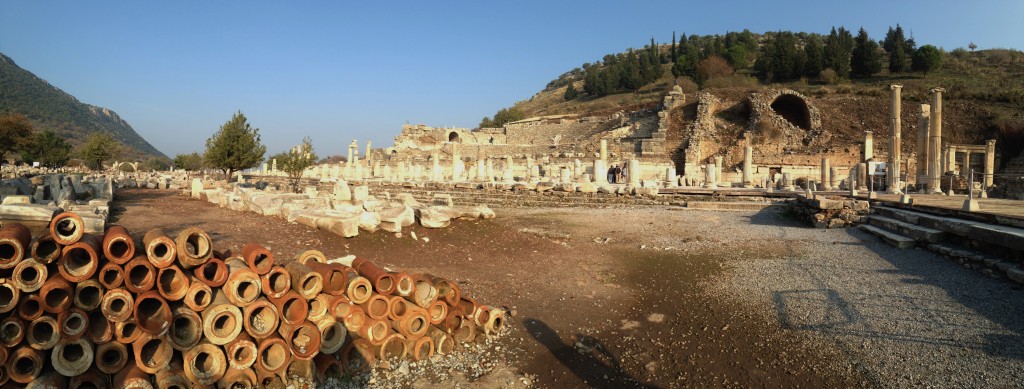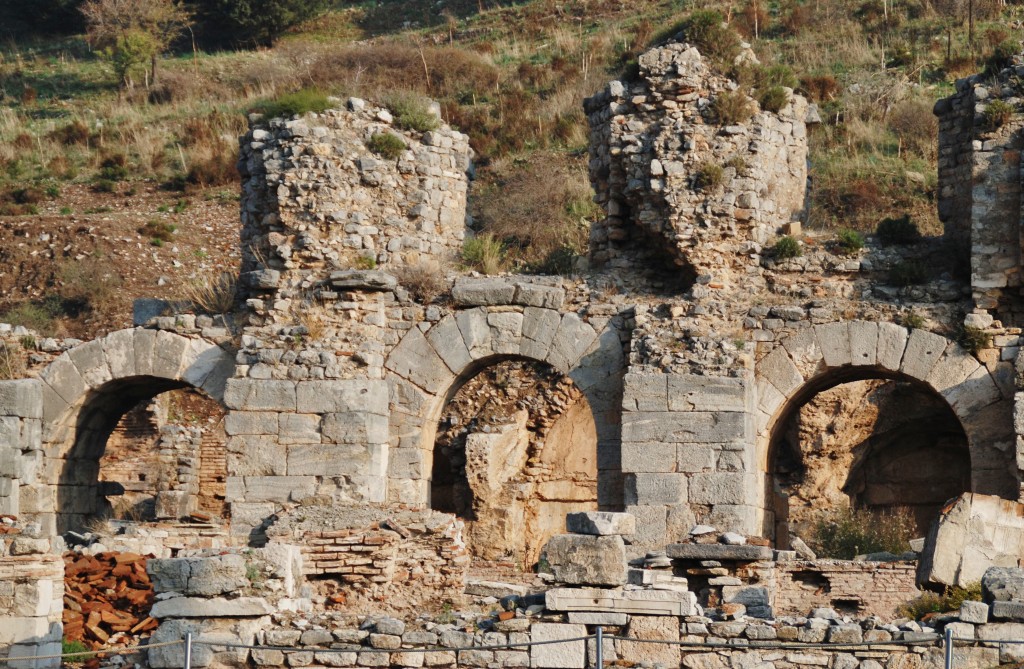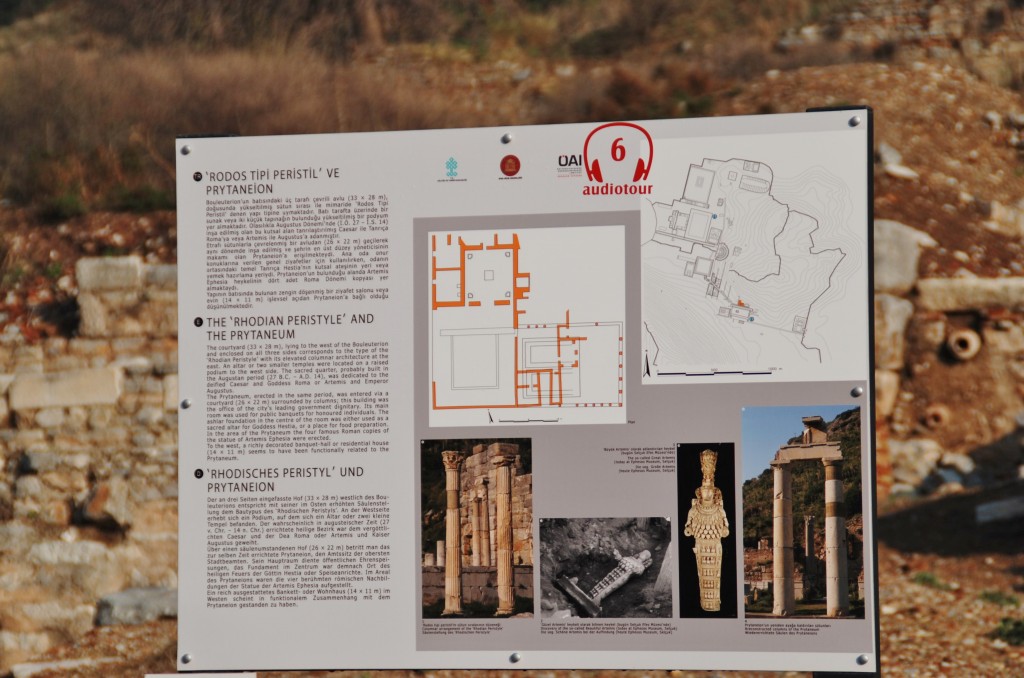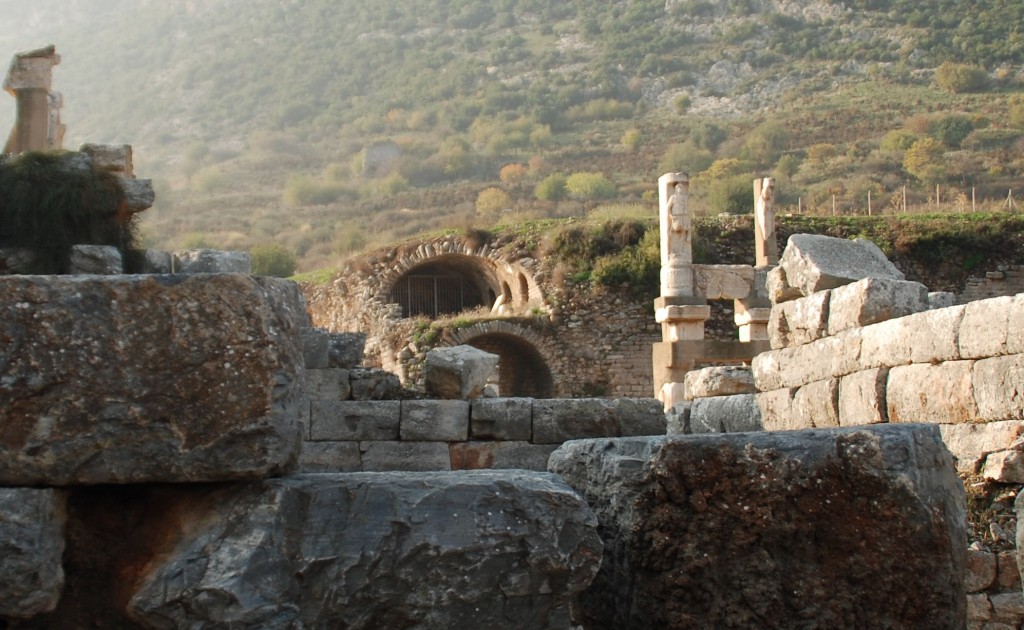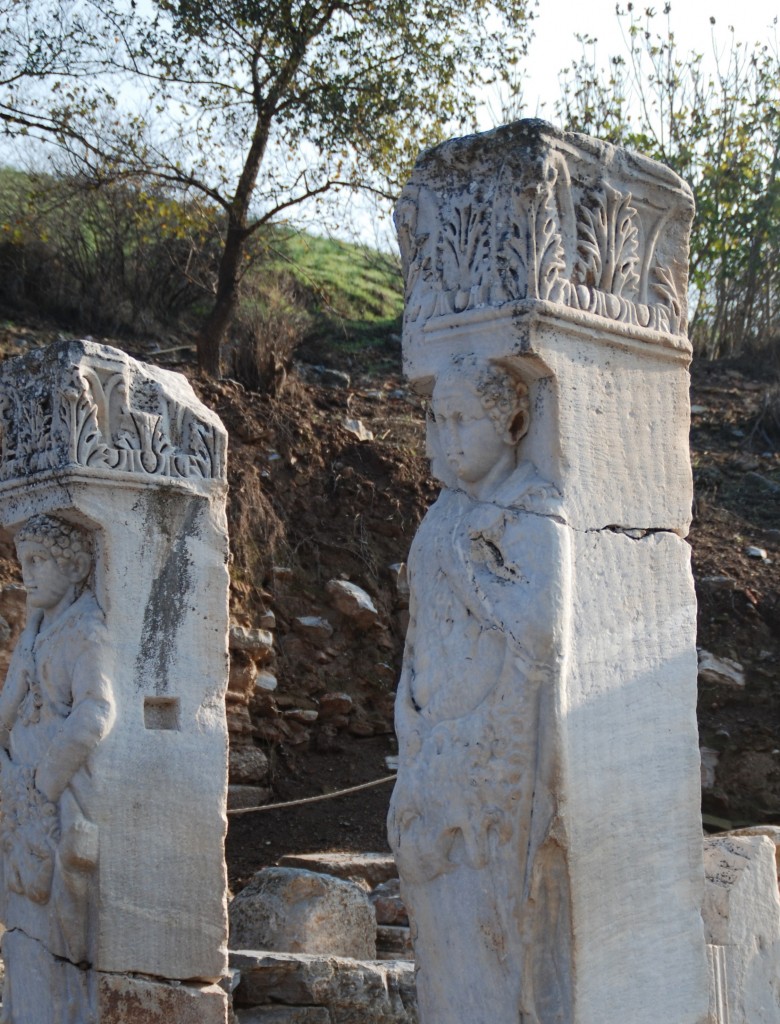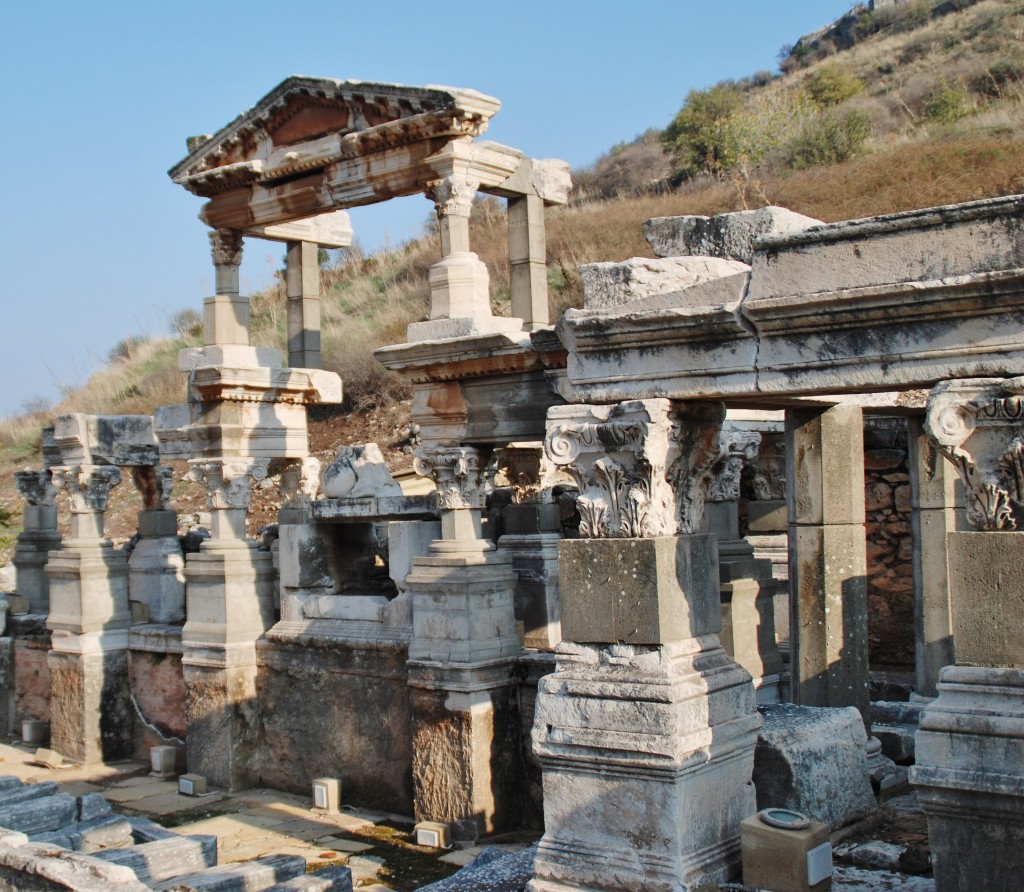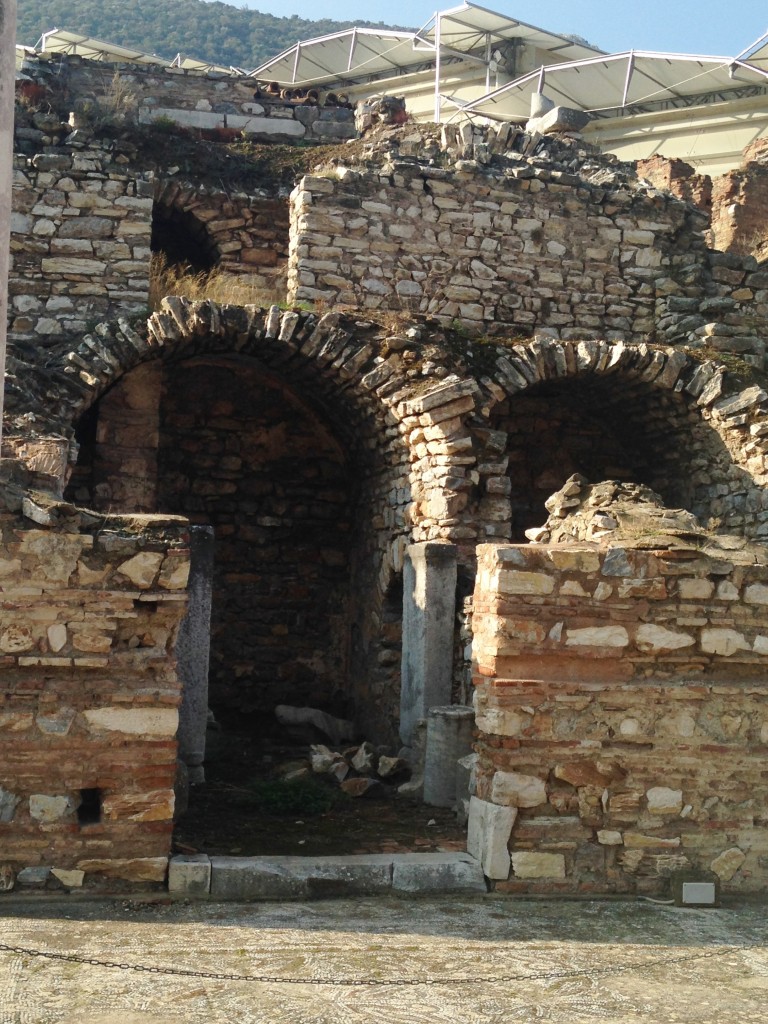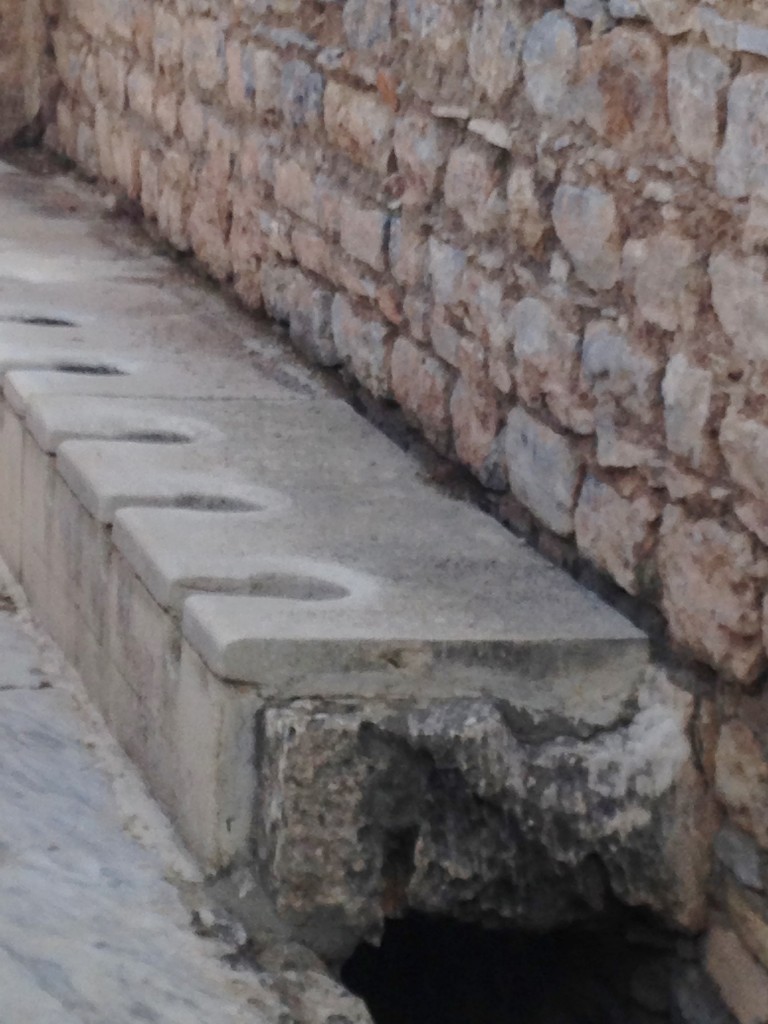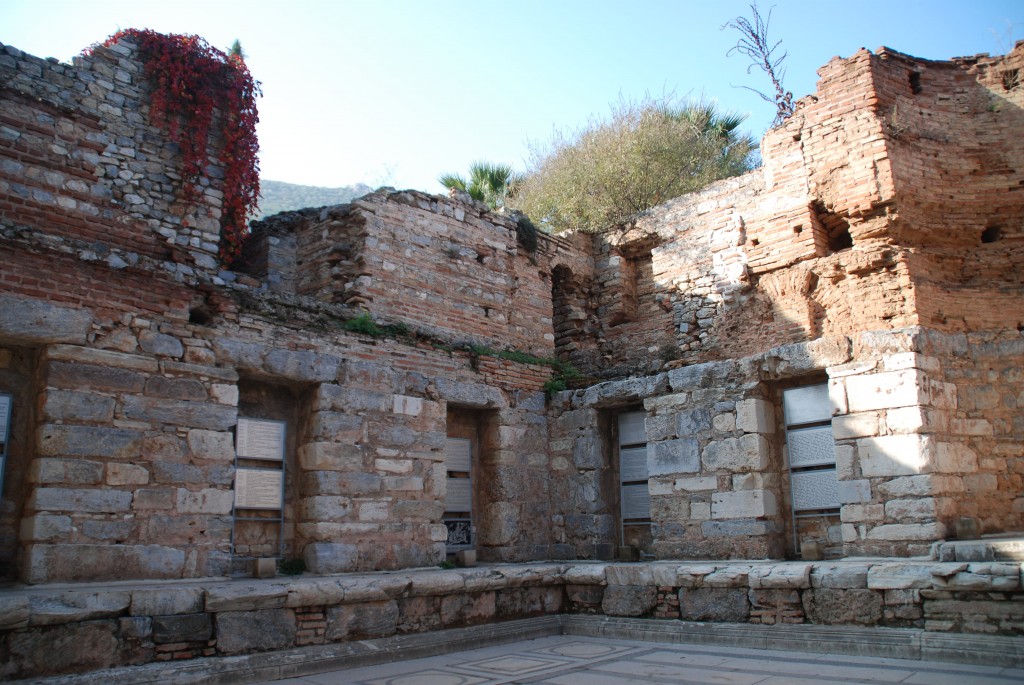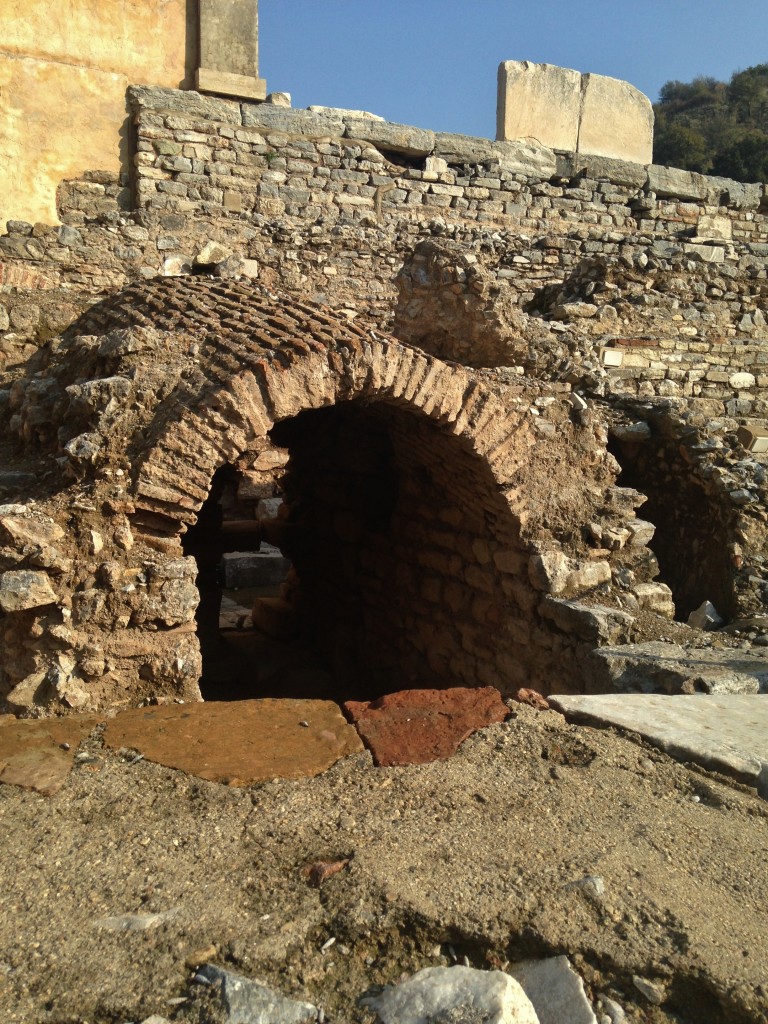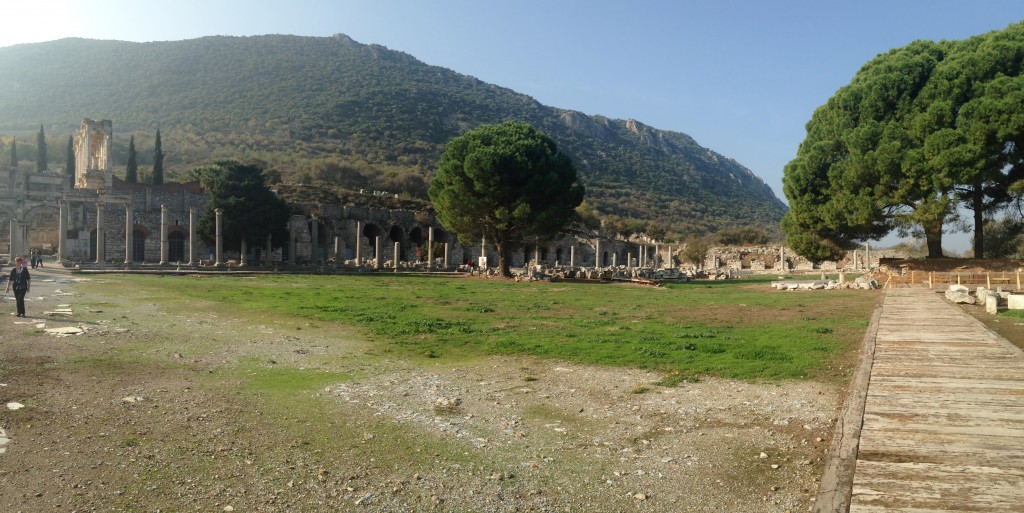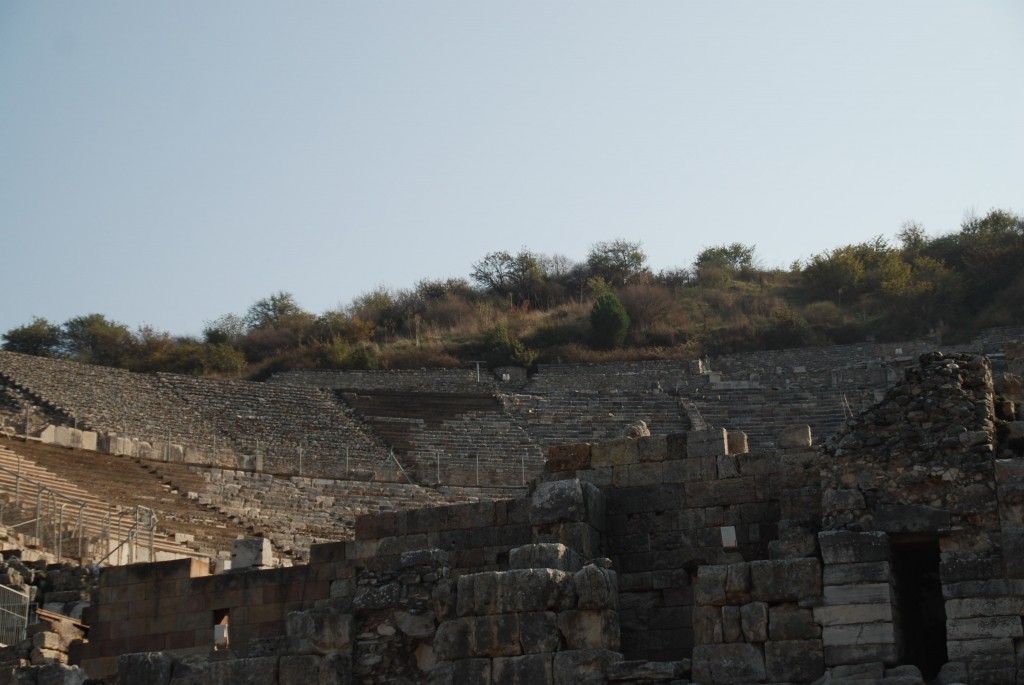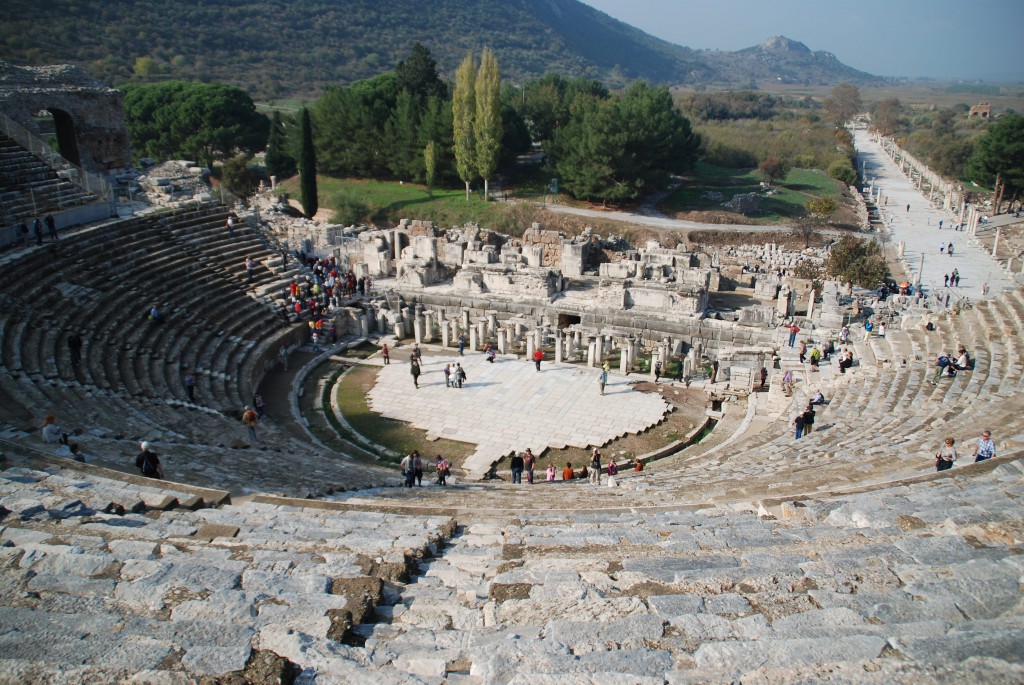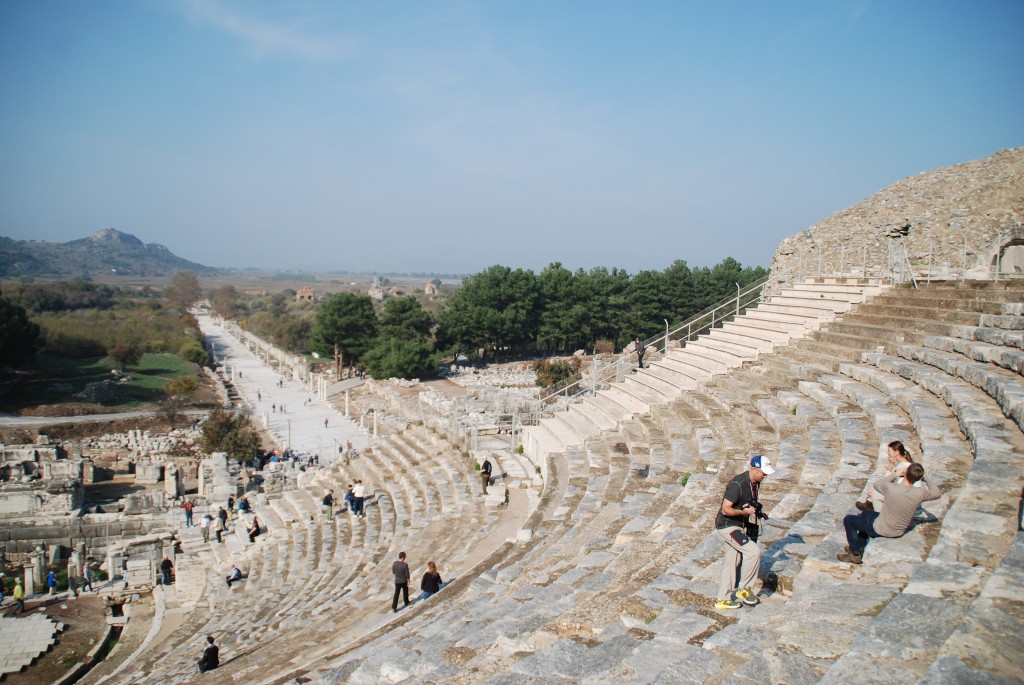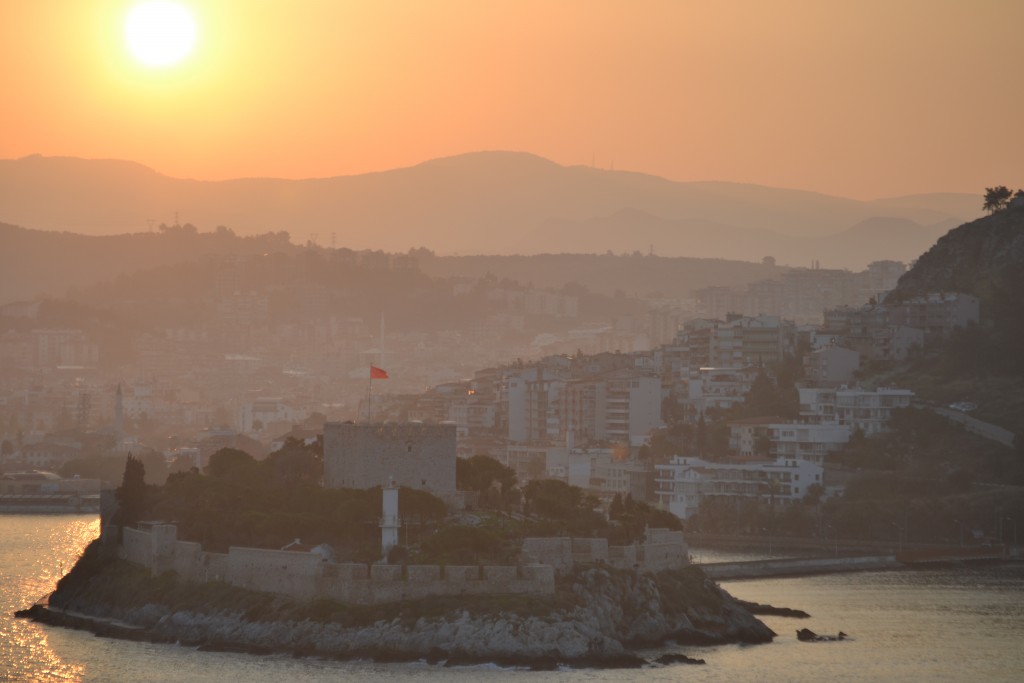 The sun shone so warmly on my face as the ship approached the cruise port of Kusadasi. The early brilliance casted shadows upon the hills that dominate the horizon while the dimness crowded out the sight of the fort that lie ahead. Kusadasi is the perfect starting point for visiting some of the most famous historical cities of Turkey. From here I will be taking a shore excursion into Ephesus, where I will have the opportunity to explore a stop on Paul’s journey to spread the gospel of Christianity. So excited to be walking in his footsteps.
The sun shone so warmly on my face as the ship approached the cruise port of Kusadasi. The early brilliance casted shadows upon the hills that dominate the horizon while the dimness crowded out the sight of the fort that lie ahead. Kusadasi is the perfect starting point for visiting some of the most famous historical cities of Turkey. From here I will be taking a shore excursion into Ephesus, where I will have the opportunity to explore a stop on Paul’s journey to spread the gospel of Christianity. So excited to be walking in his footsteps.
The Ephesians believed that Ephesia, the beautiful Amazonian queen, founded their city. The Amazons were considered descendants of the god of war, and thought to have been ferocious warriors. The temple of Hadrian tells of a second theory which credits Androklos as its founder and yet a third ideal states that the inhabitants of nearby Halikarnassus (today’s Bodrum) should be honored as the city’s organizers.
It was a quick bus ride and we arrived at the archaeological site, quickly making our way to the start of our early morning. There are two entrances leading into Ephesus; one is the Harbor Gate, and the other is the Magnesian Gate, which is where most guides begin their tours. The field of ruins that lay ahead of us is made of various fragments and cylindrical features. From where we were standing, we could see the Baths of the State Agora to the right which is an extension of the Agora, or shopping plaza, to the left.
The archaeological finds on this site date back to the 14th and 15th century BC. Only 4 – 5 % of the site has been excavated. Some of these items are housed in the Museum of Ephesus.
The Agora was one of the most important public meeting places during the Roman Empire. It was an open area that combined the civic center, administrative buildings and local market. There is a marble road that leads into the Agora from the entrance from where we are standing. The beautifully restored walkway brought us close to the architecture of the baths and we could closely see the various stone and archways created in this once thriving port town. 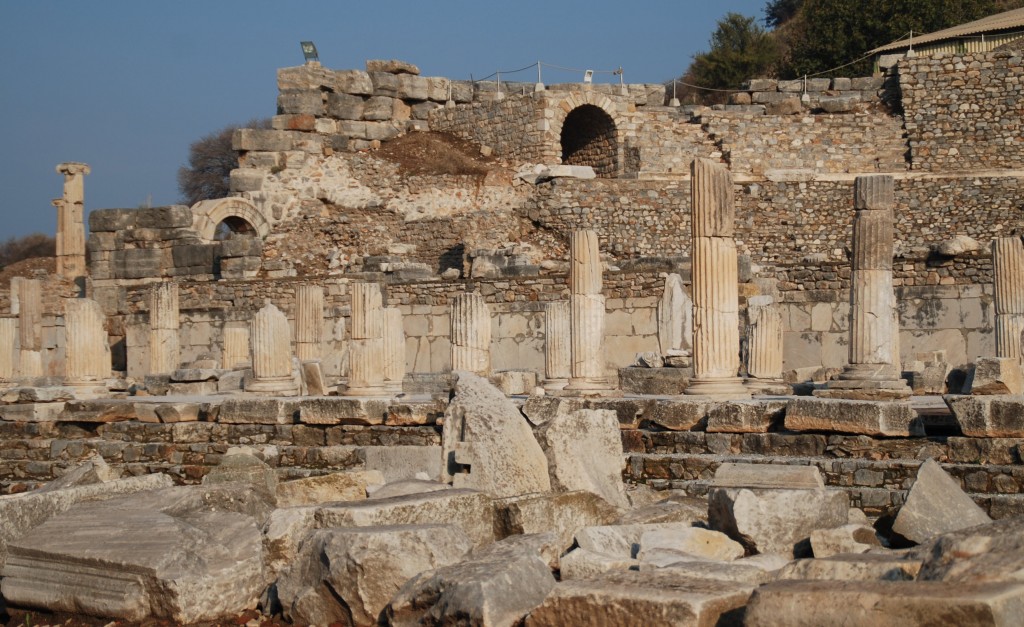
According to our tour guide, visitors and residents entering Ephesus by land would have first encountered the Agora. The primary boardwalk known as the Stoa Basileios (The Royal Walk) passed through the city’s most important structures and attractions. This road also provided access to the town’s odeon, which is similar to the theaters and music halls of today.
Passing the Agora we came upon the small town hall which was the office of the local government dignitary. Known as the Prytaneion, it was also used to host banquets for honored guests. In the center of the hall, researchers believed that there was an altar dedicated to the goddess, Hestia. Within proximity to the Prytaneion were additional statues that represented Artemis and were uncovered during the excavation of this well-preserved archaeological site.
Further off into the distance from the Prytaneion are the remains of the Roman Emperor’s Temple of Domitian. This is a two story building where displayed on the second level are the caryatids. These statues were considered a representation of the barbarian peoples that Rome had once conquered during the height of its Empire. I love the detail of these statues and find them to be some of the most well preserved artifacts along our walking tour.
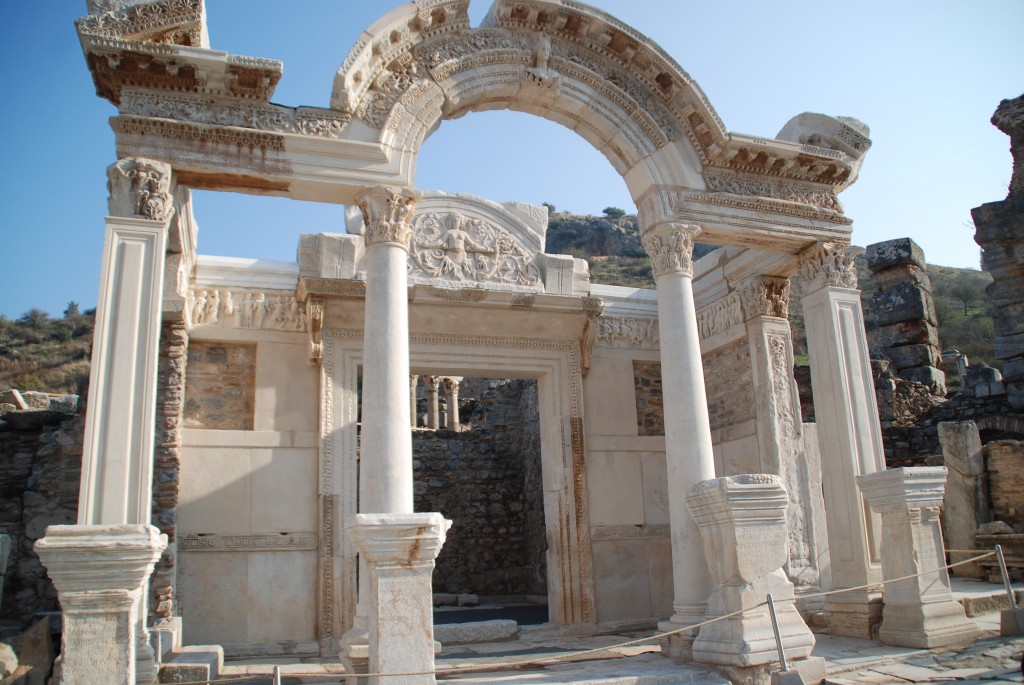 We began making our descent towards a line of columns that represented Curates (Kouretes) Street, which runs between the Library of Celsius and Domitian Street. . We approached the Temple of Hadrian to our right and immediately noticed the empty pedestals that stood in front of the temple. Those men that could afford to have their busts made could also exhibit them in this area to be recognized, in a way to flatter themselves. Hadrian’s Temple was so exquisite that I wondered how it must have appeared in the height of Ephesus’ civilization.
We began making our descent towards a line of columns that represented Curates (Kouretes) Street, which runs between the Library of Celsius and Domitian Street. . We approached the Temple of Hadrian to our right and immediately noticed the empty pedestals that stood in front of the temple. Those men that could afford to have their busts made could also exhibit them in this area to be recognized, in a way to flatter themselves. Hadrian’s Temple was so exquisite that I wondered how it must have appeared in the height of Ephesus’ civilization.
Strolling down Curates Street, we came upon the Hercules (Heracles-Greek) Gate, which separates the uptown from the downtown area of Ephesus. It is a fascinating representation of the local god, Hercules who signified masculinity and strength. Many believed that this triumphal arch was built in the 2nd century AD but was relocated here two centuries later.
The Fountain of Trajan (Trainus) is also located on Curates Street and is one of my favorite structures in Ephesus. What draws me to this building is the intricate artwork of its sculpted pillars as well as the fountain that once held a statue of the Emperor Trajan.
Across the street from the fountain are some of the most lavish homes of the elite Ephesians. The astounding floor tiles remain intact and display the wealth of the families that once lived here. Directly behind these Terrace Homes is a covered area where artifacts and additional research is being conducted. There is an additional charge to visit this small museum where audio recordings escort visitors through amazing frescoes, mosaics, and fountains that rival those of Pompeii and Herculaneum.
The tour of Ephesus is not without its elements of surprise. We arrived at a small area where slabs of marble line up against the wall and learned that they were used as public latrines. There are about forty seats, sitting side-by-side. Our guide explained that the public restrooms were important for conducting business between the men.
ail
The long awaited moment arrived as the Library of Celsus appeared in the distance. A grand structure rising from the ruins, this large two-story structure towered over us as we approached its stairway. The preservation of the library is extraordinary and the details of this building that has been so elegantly preserved.
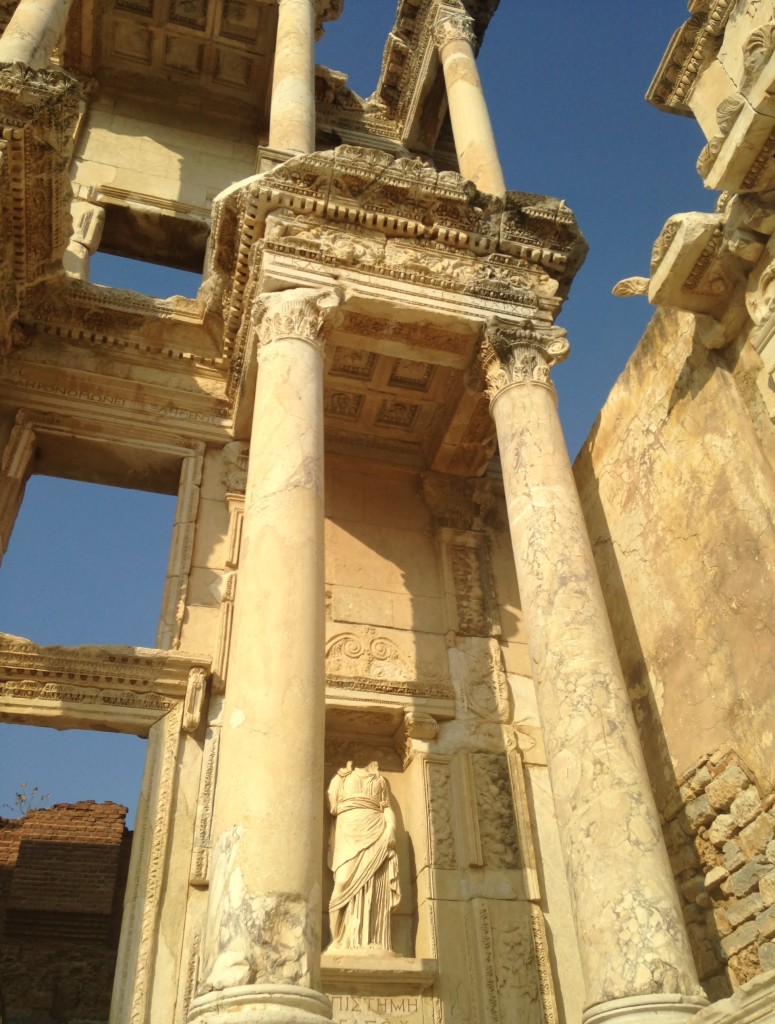
The glorious marble columns framed the four statues of the library’s façade. Each figure represented the human characteristics of wisdom, excellence, judgment and expertise. It was customary that families of financial means and power would establish monuments or heroons to honor their loved ones. The Library of Celsus was a dedication to Julius Celsus Polemeanus by his son, erected in the early 2nd century AD.
Inside of the Library of Celsus, we were met with a surprisingly simple structure that contrasted the splendid façade of the building’s exterior. In the ancient world, it was one of the largest libraries housing upwards to 15,000 scrolls. Along the inner walls were recesses that contained rolled manuscripts. This is also the burial place of Celsus, whose vault is located below the ground floor on the north side of the building.
I love the history of large cities such as Ephesus, especially those stories that involve scandal and intrigue. Our tour guide shows us an unassuming tunnel which was, according to legend, a secret passageway. It was said that the men of Ephesus would tell their wives that they were going to the library when in fact they would escape into the local brothel. There is some debate to this theory as the attitude towards sexuality was quite open during this time, but it still makes for a great story.
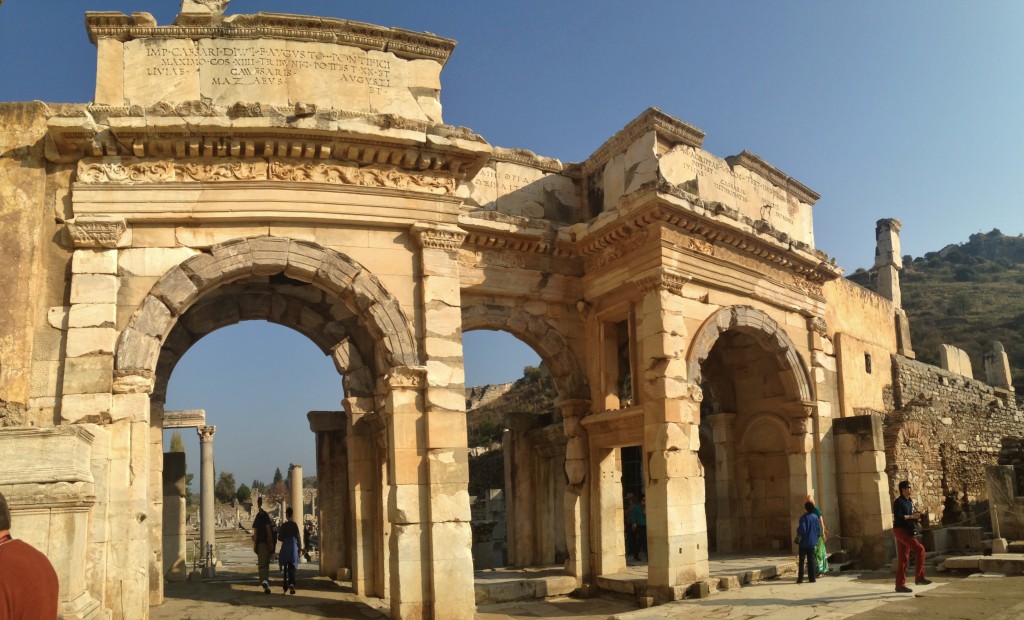
There were three arches that led out towards the Agora and Grand Theater of Ephesus called the Gates of Mazaeus and Mitridades, named after the slaves that built them. With their prominent Roman style architecture, the gates were built as a dedication to Emperor Augustus. Statues of his family could be seen towering above the arches on the attica, while a relief of the Hecate, the god of crossroads was prominent on the outer walls of the structure. Some sources refer to an inscription that was written on the gates which curses “those that piss here”. I wonder how well that deterred the locals.
Standing in the archway of the gate, I looked out into the Agora where shops once lined the courtyard and stalls were set up in the infield. I imagined the bustling square with the smell of food, domestic animals and sweating bodies crowding into the shopping plaza to make their purchases. This was once one of the most important trading centers in all of Ephesus.
Located just off of the Agora is The Great Theater. At the height of Ephesus’ prosperity, it was one of the largest theaters in the Roman-Greco world.
Following the death of Jesus, His apostles left Jerusalem to spread Christianity to the world. St. John arrived in Ephesus with Mary, the mother of Jesus, somewhere between 37 to 48 AD. John is credited for establishing the first Christian community here. John would later be exiled to Patmos, spending his remaining years on the Greek island.
St. Paul put Ephesus on the map when he arrived around 54 AD, staying for nearly three and a half years and wrote his letters here, including a letter to the Ephesian Christians. Ephesus was also included in his missionary tour and the story of his visit is detailed in the Bible, making it a stop for Christian pilgrimages as well.
Today it is one of the most visited by Christians around the world.
Viewing the theater from below is astounding, but I knew that if I climbed to the top, I would have an extraordinary view of the former harbor and surrounding area. Climbing up the rows of seats, I waited until I reached the top before turning around. Here I was rewarded with a dramatic, overwhelming view of the theater, hills and Harbor Street leading away from the city.
Through all of its splendor, I still find it somewhat difficult to imagine this lively, prosperous city of Ephesus regardless of its extraordinary restoration. This site holds not only historical significance, but biblical and archaeological importance as well. Researchers continue to excavate the city of Ephesus which provides a doorway into the lives of those that once lived here. I look forward to the time when I can return and learn what interesting facts they uncover.
Are you a fan of archaeological sites? What draws you to them? I would love to hear which historical locations you find interesting and inspiring if you would kindly leave a message in the comments section below. Many Thanks for reading about my fascinating journey to Ephesus and wishing you many Happy Travels!
What to See and What to Do:
Ephesus Archaeological Site
Ataturk Mh
Ugur Mumcu Sevgi Yolu
35920 Selcuk/Izmir, Turkey
Telephone: +90 444 MUZE (6893)
- Admission Fee: 60 Turkish Lira; children 12 and under is free of charge.
- Hours: The museum is open April – October from 8AM to 7PM, and November 1 – April 15 from 8AM to 5PM
- Amenities: Pre-purchase of ticket online, The Terrace Homes (additional cost)
- Scenic View: Beautiful views of the Celsus Library and scenes of the surrounding are are spectacular from the arena
- Length of Visit: 1 – 2 hours
- Tips for Your Visit: Arrive early in the day as there is limited cover from the sun. One can purchase tickets ahead of time. Private tours can also be purchased at the door. Wear comfortable shoes for walking. You will notice several cats that live at the site.
Where to Stay:
Livia Hotel Ephesus
Ataturk Mah. 1045 Sok. No. 25
Izmir, 39520, Selcuk, Turkey
Telephone: +90 232 892 92 99
Where to Eat:
Artemis Restaurant
Sirince Mahallesi, Sehit Yuksel
Ozulku Caddesi No. 7
35920, Sirince, Selcuk, Izmir, Turkey
Telephone: +90 232 898 32 40
I absolutely love the property surrounding the restaurant, near olive groves and vineyards. The 19th century stone building was once a village school
What to Eat:
-
- Baklava: made with puffed pastry, this dessert has chopped nuts (my favorite is pistachio), and is covered in honey.
- Gozleme is a type of bread that is shaped in a square and stuffed with various fillings such as meat, cheese, potatoes or vegetables and then cooked over a griddle. The cheese and spinach reminds me of spanikopita.
- Iskender Kebab: thinly sliced lamb is smothered in tomato sauce and served with traditional bread, then topped with yogurt and butter.
- Mezze is a sample of several small bites that may include yogurt with herbs, hummus, olives, dolmas (stuffed grape leaves), meatballs, eggplant, white cheese and warm bread.
- Simit is a fun street food bread that is similar to a pretzel.
- Turkish Apple Tea is absolutely amazing and was one of my favorite drinks while visiting Turkey.
- Turkish Delight: a delicious dessert is made up of dates, pistachios, hazelnuts, which is pink in color.
- Turkish Ice Cream, also known as Dondurma, is a little thicker in consistency, but it will not melt. A must try.
- Turkish Pizza is outstanding and tastes so fresh. Made from Turkish Pide (a type of pastry), it is similar to a flatbread with a variety of toppings.
- Turkish Ravioli: dumplings stuffed with beef or lamb served with yogurt.
What to Read:
- The Ephesus Scroll by Ben Chenoweth
- Burning of the Books at Ephesus by Sir James Thornhill
- Ancient Ephesus: The History and Legacy of One of Antiquity’s Greatest Cities by Charles River Editors
Photo Guide for Ancient Ephesus:
- The Facade of the Celsus Library
- View from the Amphitheater
Another view of the Grand Theater and Harbor Street, Ephesus
For more information about the beautiful, exotic country of Turkey, check out the following links!
Topkapki Palace
The Blue Mosque
Hagia Sophia
Spice Bazaar and Hippodrome
A Turkish Carpet Demonstration
Kusadasi and its Symbol of Peace
The Theater of Miletus
The Baths of Miletus
